Transforming Spaces: Home Interior Lighting Design Ideas and Examples
In the realm of interior design, lighting plays a pivotal role in not only illuminating spaces but also shaping the ambiance and functionality of a home. Whether it’s creating a cozy atmosphere in the living room, setting the mood in the bedroom, or enhancing functionality in the kitchen, strategic lighting design can transform any space. In this article, we will delve into various home interior lighting design ideas, covering everything from the basics of lighting design to practical tips and inspiring examples.
How To Design Lighting For Home
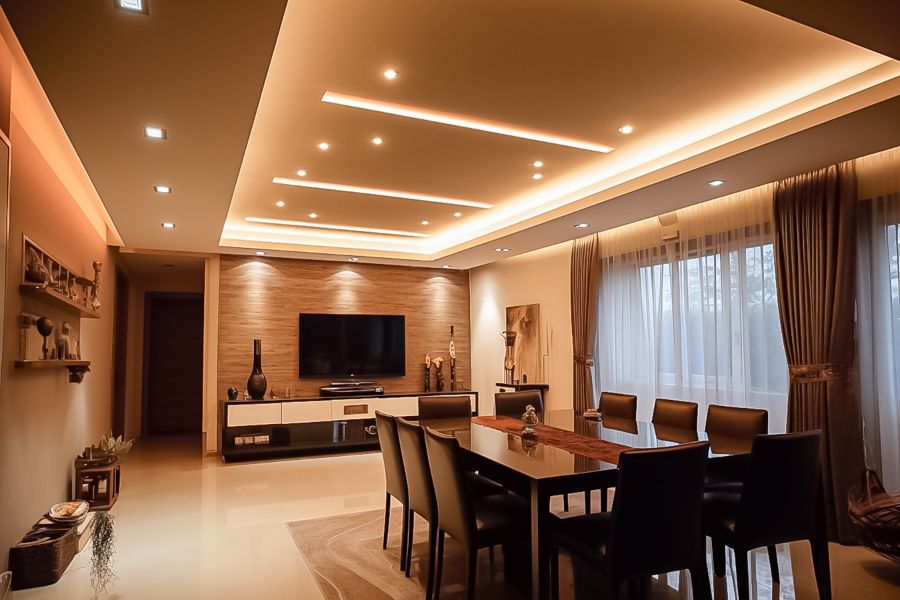
Understanding Lighting Basics
To design an effective lighting scheme for your home interior lighting design ideas, it’s important to grasp the fundamentals of lighting. This includes knowing about different types of lighting such as ambient, task, and accent lighting, understanding color temperature, and being aware of lumens. These basic principles will help you create a balanced and functional lighting plan that suits your needs.
Assessing Lighting Needs for Different Rooms
Each room in your home serves a different purpose, so it’s essential to tailor the lighting to meet those specific needs. To do this, consider factors like the size of the room, what activities will take place there, how much natural light it gets, and what preferences the users have. This assessment will guide you in determining the best lighting solution for each space.
Choosing the Right Light Fixtures
Selecting the appropriate light fixtures is crucial for achieving the desired look and functionality in your home interior lighting design ideas. Consider factors such as the style, size, finish, and how well the fixture fits into the overall design scheme of the room. It’s important to choose fixtures that not only provide adequate light but also enhance the aesthetic appeal of the space.
Placement and Layering of Lighting
Effective interior lighting design involves layering different types of lighting sources to create depth and versatility in your home interior lighting design ideas. This means incorporating ambient lighting for overall illumination, task lighting for specific activities, and accent lighting to highlight focal points or artwork. Proper placement of fixtures is key to ensuring an even distribution of light and avoiding glare or shadows, so take the time to plan out the layout carefully.
How To Use Lighting In Interior Design
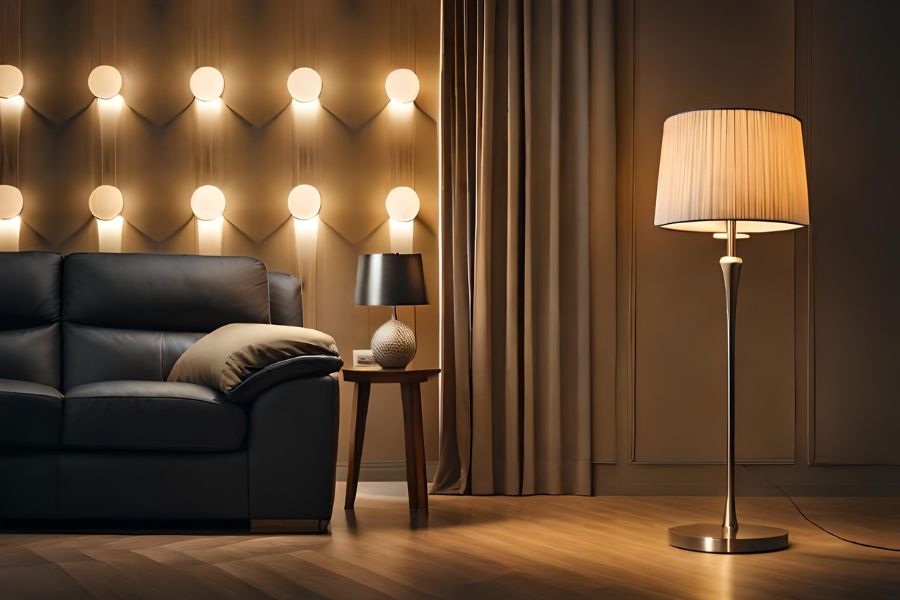
Creating Ambiance with Lighting
Lighting plays a significant role in setting the mood and ambiance of a room. By adjusting the intensity and color of light, you can create various atmospheres, from cozy and intimate to bright and energetic. For example, using warm, soft lights can make a space feel inviting and comfortable, while brighter, cooler lights can make it feel more vibrant and lively. Home Interior Lighting design ideas can help you achieve the perfect ambiance for any room in your house.
Highlighting Architectural Features
Strategic lighting can accentuate the architectural features of a home, such as exposed beams, archways, or alcoves. Use directional lighting or wall washers to draw attention to these elements and add visual interest to the space. For instance, placing a spotlight above a fireplace or along a staircase can create a dramatic effect and enhance the overall design of the room.
Incorporating Natural Light
Maximizing natural light not only reduces energy consumption but also enhances the overall aesthetic of a space. Consider window treatments that allow for both privacy and light control, such as sheer curtains or blinds, to harness natural light effectively. This can help create a bright and airy atmosphere, making the room feel more spacious and inviting. Home Interior Lighting design ideas often include maximizing natural light sources to create a welcoming and comfortable environment.
Setting the Mood with Different Lighting Scenes
Modern lighting systems offer the flexibility to create different lighting scenes for various activities or occasions. Utilize dimmers, smart lighting controls, and programmable settings to easily transition between different lighting scenarios, whether it’s hosting a dinner party or relaxing with a book. For example, you can dim the lights for a cozy movie night or brighten them up for a lively gathering with friends. With Home Interior Lighting design ideas, you can easily set the perfect mood for any occasion.
What Is Decorative Lighting In Interior Design
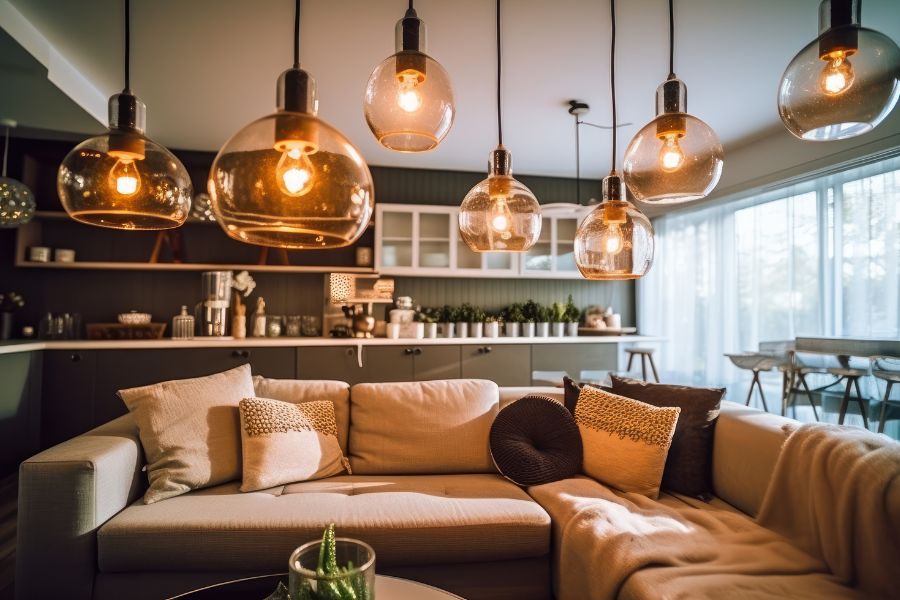
In home interior lighting design ideas, decorative lighting plays a vital role in making a space feel cozy and stylish. It’s all about adding lighting fixtures that not only brighten up the room but also look great and match the overall design theme. Let’s take a closer look at what decorative lighting is all about:
Definition and Purpose of Decorative Lighting:
Decorative lighting is all about making a statement with your lights. Unlike functional lighting, which is mainly about providing light for tasks or general illumination, decorative lighting is more about adding flair and personality to a room. It’s like the icing on the cake of your interior design, helping to highlight architectural features, create focal points, and set the mood.
The main goal of decorative lighting is to enhance the ambiance and complement the overall decor of your home. Whether it’s through elegant chandeliers, stylish pendant lights, or artistic wall sconces, decorative lighting adds that extra touch of sophistication and visual interest to any space.
Types of Decorative Lighting Fixtures
- Chandeliers: These are those fancy light fixtures that hang from the ceiling and often have multiple arms with decorative elements like crystals or metal accents. They’re perfect for adding drama and elegance to formal dining rooms or entryways.
- Pendant Lights: Pendant lights are versatile and come in various shapes, sizes, and materials. They hang from the ceiling and can be used individually or in clusters to illuminate areas like kitchen islands, dining tables, or hallways.
- Wall Sconces: Mounted on walls, wall sconces provide both ambient and accent lighting. They come in different designs, from traditional to modern, and are great for adding decorative flair to corridors, bedrooms, or bathrooms.
- Table Lamps and Floor Lamps: These are portable lighting options that not only provide light but also serve as decorative accents. They come in various styles and are perfect for bedside tables, desks, or dark corners in the living room.
- Track Lighting: Track lighting consists of adjustable fixtures mounted on a track system. While primarily used for functional lighting, they can also have decorative elements like colorful pendants, adding a modern touch to the space.
Incorporating Decorative Lighting into Design Themes
When adding decorative lighting to your home, it’s essential to consider the overall design theme and balance. Make sure the lighting fixtures match the style of the room, create balance with other elements, layer the lighting for depth and flexibility, and use them to highlight focal points or architectural features.
By following these tips, you can create a stunning and well-lit home interior that reflects your personal style and enhances the overall ambiance of your space. So go ahead and get creative with your decorative lighting choices to make your home shine!
Home Lighting Tips
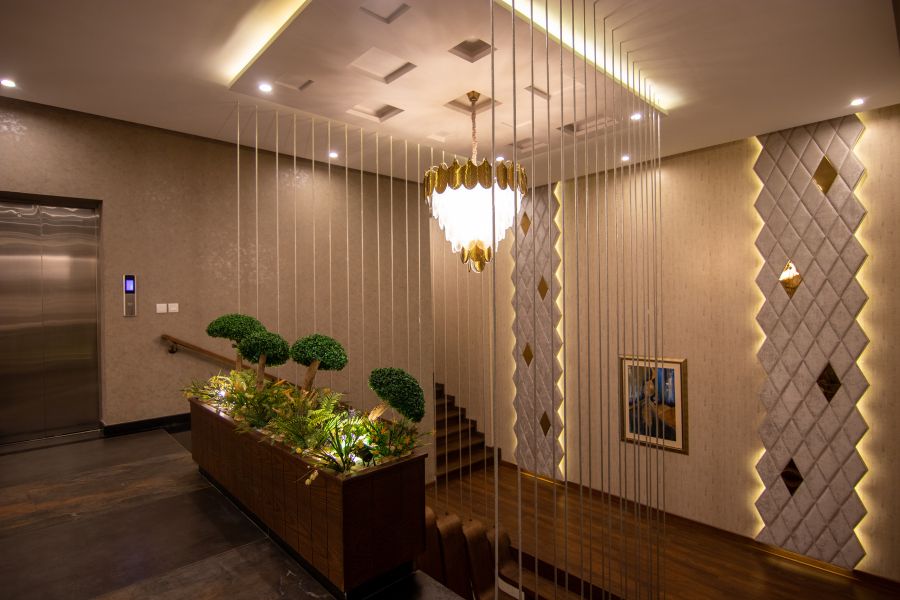
Home Interior Lighting design ideas can greatly enhance the ambiance and functionality of different spaces in your home. Let’s explore some simple tips for designing lighting in key areas like the living room, bedroom, and kitchen.
How To Design Living Room Lighting
In the living room design, it’s important to create a versatile lighting setup that suits various activities like relaxation, entertaining, and socializing. Start by layering different types of lighting, including overhead fixtures, table lamps, and floor lamps. This helps distribute light evenly across the room and adds depth to the space. Consider using accent lighting to highlight artwork or architectural features, and task lighting for reading or other activities.
Best Lighting Design For Bedroom
For the bedroom, aim to create a tranquil and cozy atmosphere conducive to restful sleep. Soft, diffused lighting is ideal for promoting relaxation, so choose fixtures with warm tones. Dimmable lights offer flexibility in adjusting brightness levels according to your mood or time of day. Place task lighting near the bed for activities like reading or getting ready. Wall-mounted or pendant lights can save space on bedside tables and add a stylish touch to the room.
Best Kitchen Lighting Design
Efficient lighting is essential in the kitchen, where tasks like cooking and meal prep require good visibility. Focus on installing task lighting above key work areas like countertops and islands to ensure adequate illumination. Under-cabinet lighting can brighten up dark corners and improve visibility while adding a modern touch to the kitchen. Pendant lights or recessed fixtures above the dining area create a welcoming atmosphere for family meals or gatherings.
By considering these simple lighting design ideas, you can enhance the functionality and ambiance of your home’s interior spaces, making them more inviting and enjoyable for everyday living.
Examples Of Lighting Design
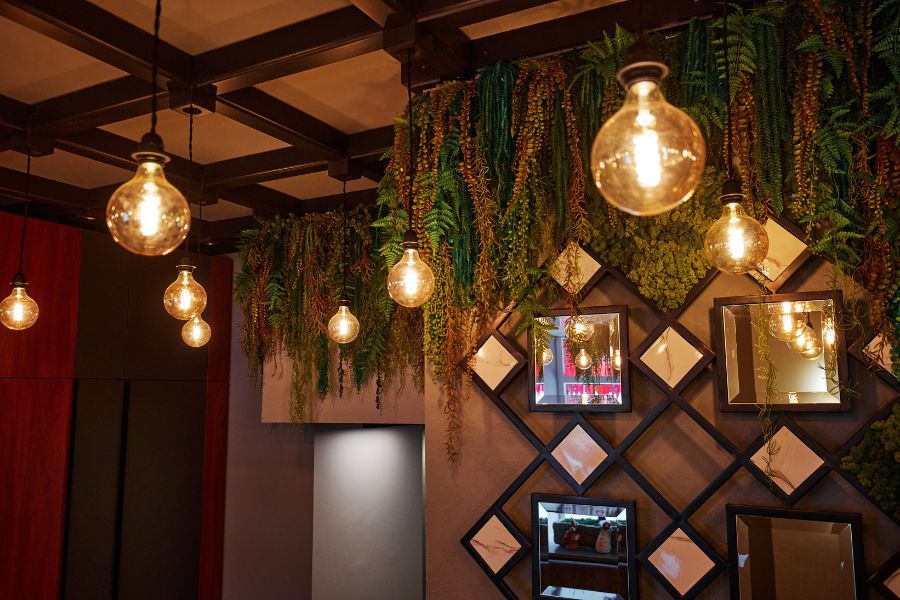
Case Studies of Well-Lit Home Interiors
In these case studies, we see how interior lighting design can transform living spaces. For example, by adding recessed lighting and a statement pendant light, a once dull living room now feels spacious and inviting. Similarly, incorporating under-cabinet lighting and pendant lights over the kitchen island not only brightens the space but also enhances functionality for cooking tasks.
Before and After Lighting Transformations
Before-and-after photos highlight the impact of interior lighting design changes. Switching from harsh overhead lighting to softer, layered lighting in a bedroom creates a cozy atmosphere conducive to sleep. Similarly, upgrading from fluorescent ceiling lights to adjustable task lighting in a home office reduces eye strain and increases productivity.
Showcase of Creative Lighting Fixtures and Installations
From handcrafted pendant lights made from recycled materials to oversized floor lamps with bold designs, these examples showcase the creativity in lighting fixtures. These pieces not only provide light but also serve as unique focal points or sculptural elements in modern interiors.
Inspiring Lighting Design Ideas from Professionals
Experts emphasize the importance of layering different types of interior lighting design, such as ambient, task, and accent, to create depth and dimension in a room. Additionally, using LED lights with high color rendering index (CRI) accurately renders colors and textures, especially in areas like the kitchen and bathroom.
Lasting Impressions
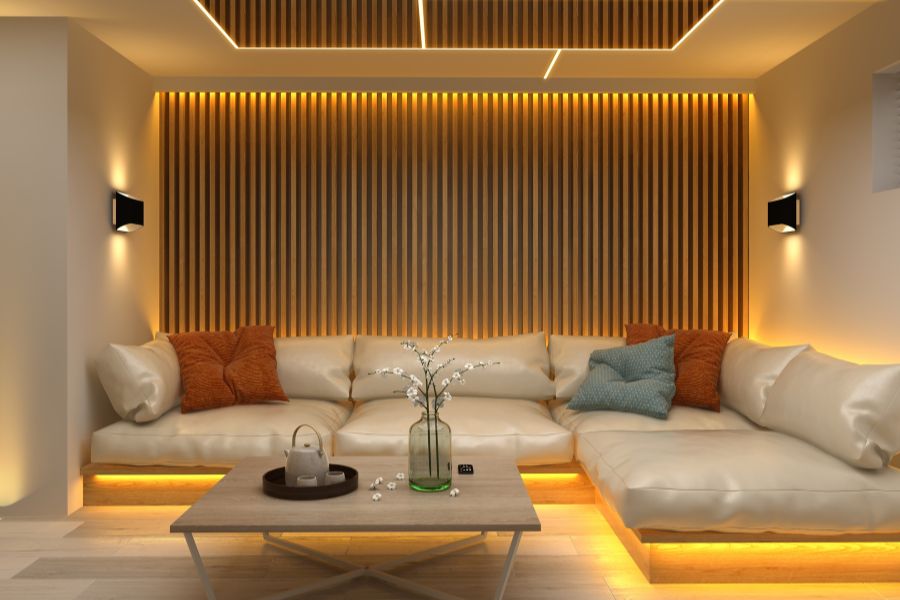
At Studio A, As an interior designing company, we believe that paying attention to lighting design can really make a difference in your home. It’s not just about having enough light; it’s about creating a space that feels beautiful, functional, and welcoming. By taking the time to understand how lighting works and exploring different options, you can design rooms that are both visually striking and well-lit. Don’t be afraid to try out different lighting techniques and fixtures to see what suits your home best. And if you ever need a helping hand, our team is here to offer professional advice and guidance. With the right lighting design, we can help you turn any room into a cozy and inviting sanctuary
FAQs: Frequently Asked Questions
1. What is interior lighting design, and why is it important?
A. Interior lighting design refers to the deliberate arrangement and selection of light fixtures within a space to achieve both functional and aesthetic goals. It is crucial because lighting greatly impacts the ambiance, mood, and functionality of a room, influencing how we perceive and interact with the space.
2. How can I incorporate interior lighting design into my home?
A. You can incorporate interior lighting design into your home by carefully assessing the lighting needs of each room, selecting appropriate fixtures, and strategically placing them to achieve balanced illumination. Consider factors such as natural light sources, room usage, and desired ambiance when designing your lighting scheme.
3. What are the different types of interior lighting?
A. Interior lighting design can be categorized into several types, including ambient lighting (general illumination), task lighting (focused illumination for specific activities), and accent lighting (highlighting architectural features or decor). By combining these types of lighting, you can create layers of illumination that enhance a space’s overall design and functionality.
4. How can I maximize natural light in my home’s interior lighting design?
A. To maximize natural interior lighting design, ensure that windows are unobstructed and use light-filtering treatments to diffuse harsh sunlight. Additionally, strategically place mirrors to reflect natural light throughout the room and consider using light-colored paint or furnishings to amplify the brightness.
Image Reference: Freepik
Disclaimer: All trademarks, logos, and brand names are the property of their respective owners. All company, product, and service names used in this website are for identification purposes only. Use of these names, trademarks, and brands does not imply endorsement.
